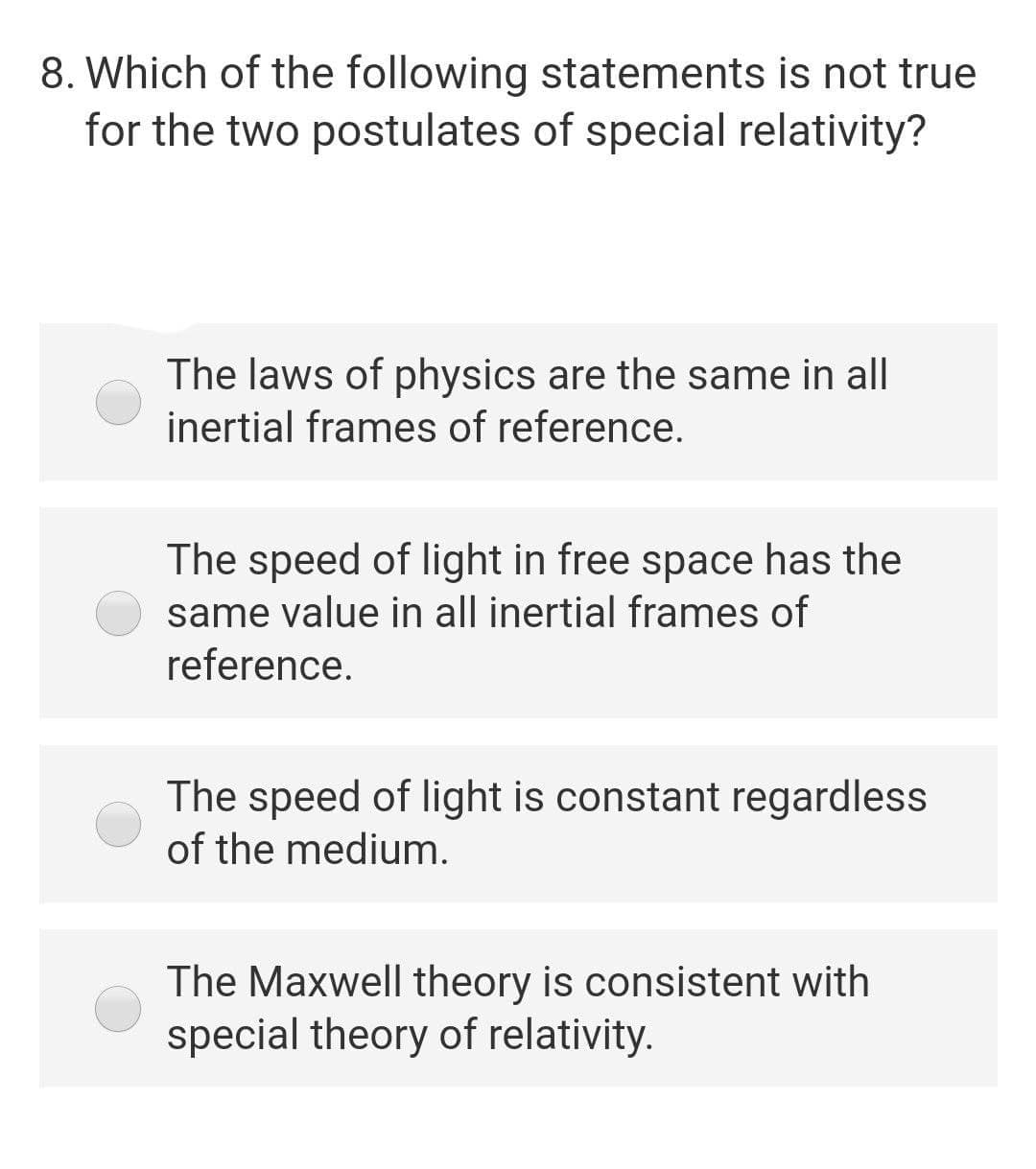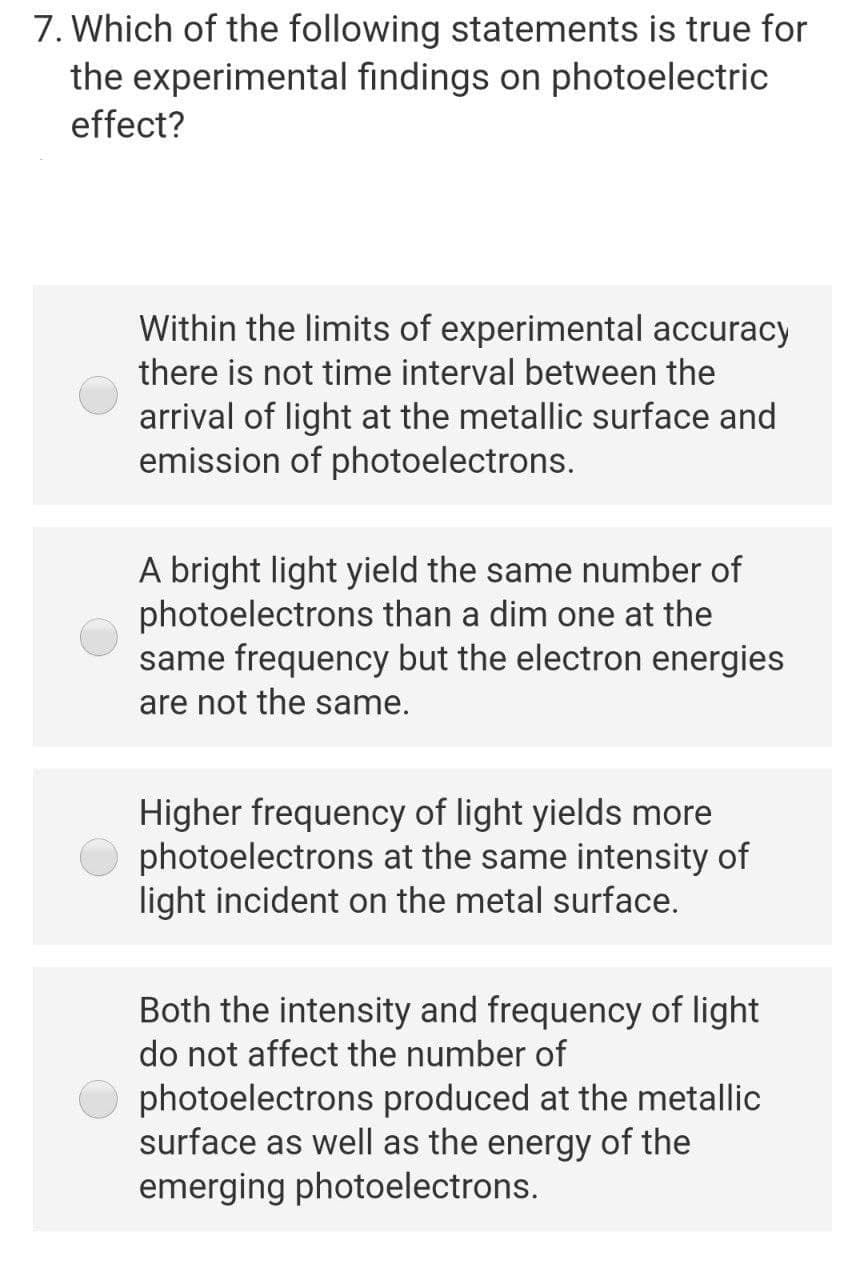8. Which of the following statements is not true for the two postulates of special relativity? The laws of physics are the same in all inertial frames of reference. The speed of light in free space has the same value in all inertial frames of reference. The speed of light is constant regardless of the medium. The Maxwell theory is consistent with special theory of relativity.
8. Which of the following statements is not true for the two postulates of special relativity? The laws of physics are the same in all inertial frames of reference. The speed of light in free space has the same value in all inertial frames of reference. The speed of light is constant regardless of the medium. The Maxwell theory is consistent with special theory of relativity.
Physics for Scientists and Engineers, Technology Update (No access codes included)
9th Edition
ISBN:9781305116399
Author:Raymond A. Serway, John W. Jewett
Publisher:Raymond A. Serway, John W. Jewett
Chapter39: Relativity
Section: Chapter Questions
Problem 39.9OQ: Which of the following statements are fundamental postulates of the special theory of relativity?...
Related questions
Question

Transcribed Image Text:8. Which of the following statements is not true
for the two postulates of special relativity?
The laws of physics are the same in all
inertial frames of reference.
The speed of light in free space has the
same value in all inertial frames of
reference.
The speed of light is constant regardless
of the medium.
The Maxwell theory is consistent with
special theory of relativity.

Transcribed Image Text:7. Which of the following statements is true for
the experimental findings on photoelectric
effect?
Within the limits of experimental accuracy
there is not time interval between the
arrival of light at the metallic surface and
emission of photoelectrons.
A bright light yield the same number of
photoelectrons than a dim one at the
same frequency but the electron energies
are not the same.
Higher frequency of light yields more
photoelectrons at the same intensity of
light incident on the metal surface.
Both the intensity and frequency of light
do not affect the number of
photoelectrons produced at the metallic
surface as well as the energy of the
emerging photoelectrons.
Expert Solution
This question has been solved!
Explore an expertly crafted, step-by-step solution for a thorough understanding of key concepts.
This is a popular solution!
Trending now
This is a popular solution!
Step by step
Solved in 2 steps

Knowledge Booster
Learn more about
Need a deep-dive on the concept behind this application? Look no further. Learn more about this topic, physics and related others by exploring similar questions and additional content below.Recommended textbooks for you

Physics for Scientists and Engineers, Technology …
Physics
ISBN:
9781305116399
Author:
Raymond A. Serway, John W. Jewett
Publisher:
Cengage Learning

University Physics Volume 3
Physics
ISBN:
9781938168185
Author:
William Moebs, Jeff Sanny
Publisher:
OpenStax

College Physics
Physics
ISBN:
9781305952300
Author:
Raymond A. Serway, Chris Vuille
Publisher:
Cengage Learning

Physics for Scientists and Engineers, Technology …
Physics
ISBN:
9781305116399
Author:
Raymond A. Serway, John W. Jewett
Publisher:
Cengage Learning

University Physics Volume 3
Physics
ISBN:
9781938168185
Author:
William Moebs, Jeff Sanny
Publisher:
OpenStax

College Physics
Physics
ISBN:
9781305952300
Author:
Raymond A. Serway, Chris Vuille
Publisher:
Cengage Learning

College Physics
Physics
ISBN:
9781285737027
Author:
Raymond A. Serway, Chris Vuille
Publisher:
Cengage Learning

College Physics
Physics
ISBN:
9781938168000
Author:
Paul Peter Urone, Roger Hinrichs
Publisher:
OpenStax College

Principles of Physics: A Calculus-Based Text
Physics
ISBN:
9781133104261
Author:
Raymond A. Serway, John W. Jewett
Publisher:
Cengage Learning